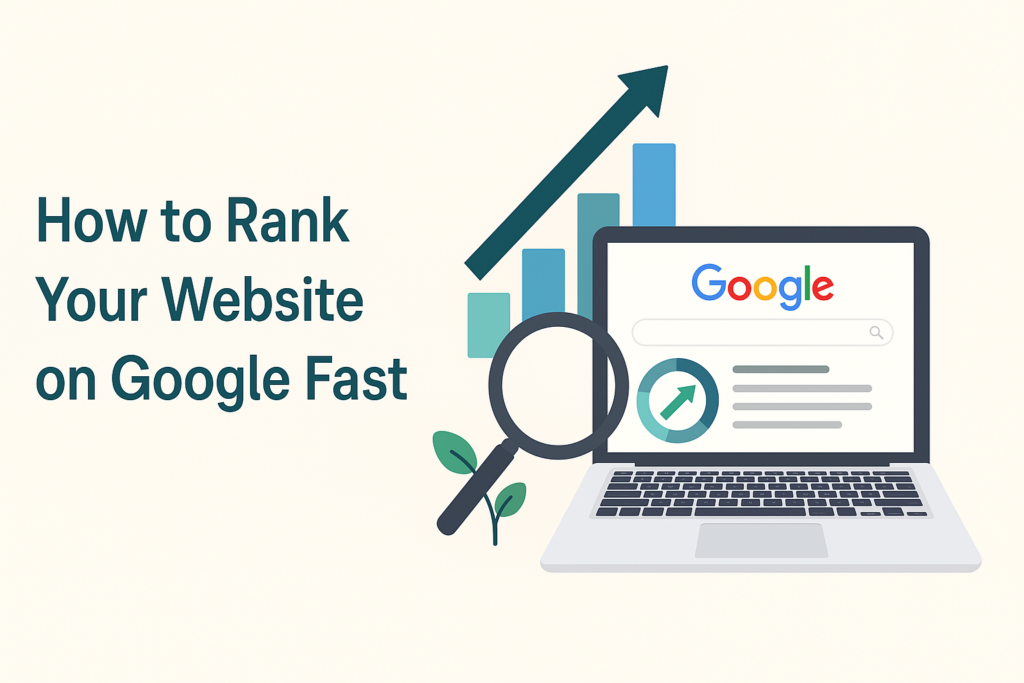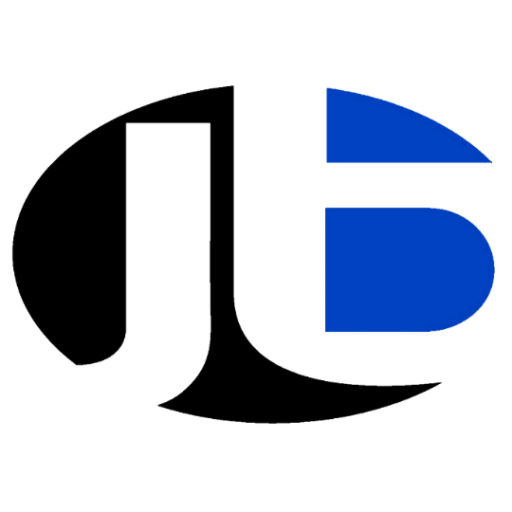Are you wondering how to rank your website on Google fast without falling into the trap of outdated or black-hat SEO tactics? You’re not alone. Every website owner, blogger, or digital marketer wants to see their site on the first page of Google — ideally at the top.
How to Rank Your Website on Google Fast: A Complete Guide for Beginners

In this detailed guide, you’ll discover practical, ethical, and fast-working SEO techniques that will help you climb the search rankings and stay there. Whether you’re building a blog, eCommerce store, or service-based site, the strategies below will give you a clear, action-oriented path to success.
Why It’s Crucial to Rank on Google Fast
First things first — why does ranking fast on Google even matter?
-
70% of searchers never go beyond the first page of Google.
-
The top 3 results receive over 50% of all clicks.
-
Ranking higher means more traffic, more leads, and more sales — faster.
Now, let’s dive into the step-by-step approach to help you rank your website quickly while maintaining long-term authority.
1. Start with Long Tail Keyword Research (Key to Ranking Fast)
One of the fastest ways to rank on Google is by targeting long tail keywords. These are more specific and less competitive than broad terms.
✅ How to Find Long Tail Keywords:
-
Use tools like Ubersuggest, AnswerThePublic, or Google Autocomplete.
-
Target questions people ask like “how to rank a small business website fast on Google.”
-
Look at forums and Reddit threads to discover actual search queries.
Pro Tip: Use keyphrases that are voice-search friendly, such as “what’s the fastest way to rank a website on Google?”
2. Optimize Your On-Page SEO for Keyphrases
To make your content SEO-friendly, you must optimize for keyphrases strategically.
🔍 Key On-Page Optimization Steps:
-
Include your keyphrase in the title, URL, and first 100 words.
-
Use the keyphrase and its synonyms in H2s and H3s.
-
Maintain a keyphrase density of 0.5–2.5% (as per Yoast SEO).
-
Add image alt tags with keyphrases.
-
Use internal links to other relevant blog posts.
Transition tip: Not only does this help Google understand your content, but it also improves your page’s relevance in search results.
3. Write for Humans First, Then for Search Engines
To rank your website on Google fast, you must focus on readability. Google’s algorithm favors content that is easy to understand and provides real value.
📘 Tips to Boost Readability:
-
Use short paragraphs (2–4 lines).
-
Include transition words like “moreover,” “as a result,” “in other words,” and “for example.”
-
Add bullet points, numbered lists, and bold highlights.
-
Stick to active voice only.
-
Aim for a Flesch Reading Ease Score above 60.
Remember, clear content = higher dwell time = better rankings.
4. Create Engaging Meta Titles and Descriptions
Even though meta descriptions don’t directly impact rankings, they influence click-through rate, which does.
🎯 Best Practices for Meta Tags:
-
Include your keyphrase in the meta title and description.
-
Keep the title under 60 characters and description under 160.
-
Use power words like “quick,” “simple,” or “easy-to-follow.”
Example: How to Rank Your Website on Google Fast – 10 Quick SEO Wins You Can Try Today
5. Mobile Optimization is a Must
Since Google uses mobile-first indexing, your website must perform well on smartphones and tablets.
📱 Optimize for Mobile By:
-
Using responsive themes.
-
Ensuring fast load times (under 3 seconds).
-
Keeping buttons and fonts finger-friendly.
Transitioning to a mobile-first experience can significantly improve your bounce rate and engagement metrics.
6. Speed Up Your Website (Page Speed = Higher Rankings)
Website speed is a ranking factor — and a major one for voice search too!
⚡ Speed Optimization Tips:
-
Compress images using TinyPNG or ShortPixel.
-
Minify CSS, HTML, and JavaScript.
-
Use lazy loading for images and videos.
-
Host your site on reliable, fast servers.
Faster websites don’t just rank better; they convert more visitors into customers.
7. Create High-Quality, In-Depth Content
To outrank your competitors, your content must be better, longer, and more helpful than theirs.
📝 Write Content That:
-
Answers all the questions a user might have.
-
Includes FAQs to target voice searches.
-
Features original insights, data, or visuals.
-
Uses schema markup for rich results.
When you offer comprehensive solutions, users stay longer — and Google notices that.
8. Build Backlinks the Smart Way
Backlinks are like votes of confidence for your website. But not all links are created equal.
🔗 Ways to Build High-Quality Backlinks:
-
Guest post on reputable sites in your niche.
-
Create linkable assets (guides, infographics, tools).
-
Answer questions on Quora, Reddit, and niche forums.
-
Use HARO (Help a Reporter Out) to get featured in articles.
Link-building accelerates your SEO progress, especially when combined with great content.
9. Use Internal Linking for Better Indexing
Internal links help Google crawl your site better and keep users engaged longer.
🔄 Smart Internal Linking Tips:
-
Link to related blog posts using anchor text that includes your keyphrase.
-
Use breadcrumb navigation for better user experience.
-
Don’t overdo it — aim for 3–5 internal links per 1000 words.
Every link you add should provide clear value to the reader.
10. Submit Your Site to Google Search Console
To help Google discover and rank your content quickly, submit your site and new pages to Google Search Console.
🛠️ Steps:
-
Verify your site in Search Console.
-
Submit a sitemap.xml.
-
Use the URL inspection tool to request indexing of new content.
Doing this signals to Google: “Hey, check this out!” — and speeds up your visibility.
BONUS: Voice Search Optimization for Faster Rankings
With the rise of smart assistants, more users are asking questions like:
-
“How do I rank my blog on Google fast?”
-
“What’s the best SEO strategy for new websites?”
To capture voice search traffic:
-
Use conversational language.
-
Add FAQ sections with question-based subheadings.
-
Optimize for featured snippets by using direct answers.
✅ Final Checklist to Rank Your Website on Google Fast
Before you hit publish, make sure you:
-
Used a long-tail keyphrase effectively.
-
Kept keyphrase density within Yoast SEO guidelines.
-
Maintained high readability with transition words and active voice.
-
Optimized meta tags, images, speed, and mobile.
-
Added internal links and backlinks.
-
Targeted voice search with FAQs and natural phrasing.
🚀 Conclusion: Your Fast Track to Google Rankings Starts Now
Ranking your website on Google fast isn’t just possible — it’s achievable with the right strategy and consistent action. By implementing these proven SEO tips, you’ll not only climb search engine results quickly but also build lasting authority in your niche.
So, don’t just sit back and hope to rank. Take these steps today — because your audience is out there searching for the content you offer. Make sure they find you first.
Top 20 FAQs
1. How can I rank my website on Google fast?
To rank your website on Google quickly, focus on long tail keywords, optimize on-page SEO, create high-quality content, build backlinks, and ensure your site is mobile-friendly and fast-loading.
2. How long does it take to rank on Google?
It typically takes 3 to 6 months to see noticeable results, depending on your competition, content quality, and SEO efforts. However, targeting low-competition long tail keywords can produce faster results.
3. What are long tail keywords and why are they important?
Long tail keywords are specific keyword phrases like “best SEO strategy for new websites.” They’re less competitive and easier to rank for, especially when you’re starting out.
4. What’s the best tool to check website ranking?
Popular tools include Google Search Console, Ahrefs, SEMrush, Ubersuggest, and SERPWatcher. These platforms track keyword positions and SEO progress.
5. Can I rank a website without backlinks?
Yes, especially for low-competition keywords. However, backlinks speed up ranking and add authority to your site in Google’s eyes.
6. How important is mobile optimization for ranking?
Extremely important. Google uses mobile-first indexing, meaning your mobile site determines how you rank, even on desktop.
7. What’s the ideal content length for Google ranking?
Content that is 1,200–2,500 words generally performs better. Google favors comprehensive, helpful content that answers all user questions.
8. How do I use internal links to improve SEO?
Link to relevant blog posts or pages using anchor text that includes your keyphrases. This helps Google understand your content structure and improves crawlability.
9. How many keywords should I target per page?
Focus on one main focus keyword and include 3–5 related keyphrases or synonyms. Avoid keyword stuffing and prioritize natural flow.
10. Is it necessary to use HTTPS for ranking?
Yes. Google considers HTTPS a ranking factor. It also builds trust with users by keeping data secure.
11. What is voice search optimization and how can it help?
Voice search involves optimizing content for natural, conversational queries. Use question-based headings and provide short, direct answers to boost chances of appearing in voice results.
12. Should I create a sitemap for faster indexing?
Absolutely. A sitemap helps Google crawl and index your website faster. Submit it through Google Search Console for best results.
13. How do I optimize images for SEO?
Use descriptive file names, add alt text with keyphrases, compress images for speed, and use WebP format where possible.
14. How often should I update my content?
Update your content every 3–6 months to keep it fresh, accurate, and relevant. Google prefers updated content that reflects current search intent.
15. What is a featured snippet and how do I get one?
A featured snippet is the answer box at the top of Google. To win it, format content with clear headings, bullet points, and answer questions directly and concisely.
16. Can I rank a new website quickly?
Yes, by targeting low-competition, long tail keywords, creating high-quality content, and submitting your site to Google Search Console, you can gain traction quickly.
17. Does social media affect my Google ranking?
Indirectly. While social signals aren’t direct ranking factors, sharing content on social platforms increases visibility, backlinks, and engagement.
18. What’s the role of page speed in SEO?
Page speed is a direct ranking factor. A slow website leads to high bounce rates, hurting your SEO. Optimize images, code, and server response time.
19. How do I know if my SEO strategy is working?
Track metrics like:
-
Keyword rankings
-
Organic traffic growth
-
Bounce rate
-
Time on site
-
Conversions
Use Google Analytics and Google Search Console to monitor progress.
20. Do I need a blog to rank higher on Google?
Yes, a blog helps you target multiple long tail keywords, build authority, and generate fresh content — all of which Google loves.









